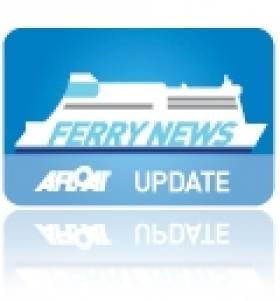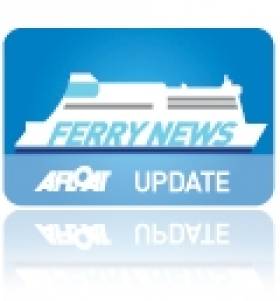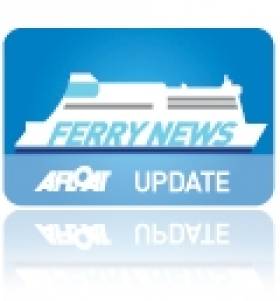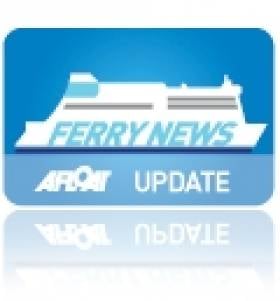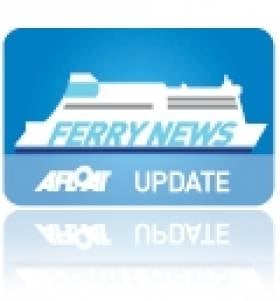Displaying items by tag: LarneTroon
P&O Express Lays Up Leaving Ro-Pax Sisters on Scottish Service
#P&ONorthChannel - As the Express sailed into Belfast Lough this morning, the P&O Ferries fast-craft's presence marked the end of her summer-only season service on the Larne-Troon route, writes Jehan Ashmore.
Express (1998/5,902grt) is standing down for the Winter months at a berth on the Lagan in Belfast Harbour, having served the season of the 1 hour route linking Antrim and Ayrshire.
The InCat 91m fast-craft with a capacity for 868 passengers and 195 cars, has been in service on this link for nine years.
In the previous winter lay-up again in Belfast, she was refitted at cost of £500,000 to upgrade standards in service. No doubt the refit was in response to Stena Line's 'Superfast' conventional tonnage introduced in late 2011 on the Belfast-Cairnryan route.
In addition upgrades were also applied to P&O Ferries conventional ro-pax sisters serving Larne to Cairnryan crossings taking 1 hour 45 minutes in competition to Stena's longer passage time of an added 30 minutes.
P&O Ferries ‘Express’ Returns to Troon Service!
#P&Oexpress - P&O Ferries fast-craft Express that sails between Larne-Troon returns to service this week and just in time for the forthcoming holiday season.
The 91m InCAT built Express is the fastest ferry on the most direct route for passengers travelling from Northern Ireland to central Scotland.
Glasgow is just 45 minutes from the Port of Troon and Edinburgh is not much further, making day trips – whether for business or pleasure, easy and accessible.
Neal Mernock, Sector Director – Irish Sea, P&O Ferries, said: "I'm delighted to announce the return of the Fastcraft service between Larne and Troon. From today, the fast-craft provides passengers sailing from Northern Ireland an even greater choice on their Irish Sea crossings. It's a popular service for both leisure and business customers and we're looking forward to welcoming everyone on board today and throughout the season".
With up to 4 sailings a day, prices start from £99 one way to Troon for a car and one person, passengers also have the option to upgrade to Club Lounge. Tickets booked in advance cost £12 per person while tickets purchased on board cost £14 per person.
For further information visit: www.poferries.com
Countdown to P&O Express Scottish Service
#P&OExpress – A month to go sees the return of P&O Ferries fastcraft 'Express' service on the two-hour Larne-Troon route, which operates from 27 March to October.
The P&O Express (1998/5,902grt) accommodates more than 800 passengers and nearly 200 vehicles on the short hop across the North Channel linking Antrim and Ayrshire. The fastcraft also operates on certain sailings in tandem with ro-pax ferries running on the Larne-Cairnryan route.
On board facilities include a Fables Restaurant, the Harbour Coffee Company and for shoppers at sea, a stroll around the spacious Seashop.
Like other Irish Sea fast-ferries during the winter months, these vessels would go into 'hibernation' mode. As for the Austal built Express 91m craft completed in Fremantle, she spent several months lying in Belfast Harbour.
For further details of the P&O Express service on the Larne-Troon service click HERE.
Seasonal Start for Three In A Row
#FERRY NEWS – By this weekend three seasonal-only operated routes from the island of Ireland will have resumed service since the recent change of the clocks marking the start of summertime, writes Jehan Ashmore.
Sailings started today on Stena Line's Dun Laoghaire-Holyhead (120 minutes) fast-craft HSS Stena Explorer operated service. The central corridor route closed last September due to cost-saving measures as previously reported. For further details on sailing schedule click HERE.
The reopening of the Welsh route follows yesterday's launch of P&O Ferries fast-craft sailings to Scotland between Larne-Troon (2 hours) served by the 92m Express. She also runs additional sailings on the year-round Larne-Cairnryan route served by a pair of conventional ferry sisters. To read more information on both sailing route schedules click HERE.
The remaining route to re-open is Brittany Ferries Cork-Roscoff (14 hours) service operated by the 2,400 passenger 'flagship' Pont-Aven, which features an indoor swimming pool. Her first sailing for this year is tonight's sailing from the Breton port.
The corresponding Irish sailing departs tomorrow afternoon and the inaugural round trip is due to be completed with an arrival in France on Sunday morning. For sailing times click HERE.
Former B+I Line Freight-Ferry Bound for Turkish Breakers
#FERRY NEWS-P&O Irish Sea's Larne-Troon freight-ferry Norcape (14,087grt) departed the Co. Antrim port last week to be broken-up at ship-breakers in Aliaga, Turkey. She originally served B+I Line as the Tipperary, but her last sailings took place on the North Channel in late November, as the ageing vessel is in her fourth decade of service, writes Jehan Ashmore.
The 125-trailer capacity ro-ro was not replaced on the single-ship operated route which closed for the winter months, though sailings will resume next March by the 92m fast-ferry Express. In the meantime freight traffic will be accommodated on the companies Larne-Cairnryan service.
Yesterday morning Norcape transitted the Strait of Gibraltar having called en-route to Falmouth several days previously. She represented the last vessel to serve in Irish waters with a direct link to B+I Line, the state-owned operator which was sold in 1992 to ICG, parent company of Irish Ferries.
When she arrives in Aliagra, this is where her former P&O fleetmate European Mariner (5,897grt) was scrapped after also serving Larne-Troon sailings until last July. Norcape entered the North Channel route replacing the smaller 53-trailer capacity vessel.
Prior to then Norcape had been in laid-over in Liverpool docks when European Endeavour replaced her in February on the Dublin-Liverpool route. To read more click HERE.
Norcape's return to the Irish Sea service in 2009, reflected her original career for P&O. She was named Puma in 1979 from the Japanese shipyard at the Mitsui Engineering & SB Co Ltd, Tamano, however she was chartered to B+I Line and renamed Tipperary. To read more and to view a deck-drawing profile, click HERE.
Her career started with a new Dublin-Fleetwood route jointly operated with P&O, who contributed with a sister, the Ibex. The P&O brand name Pandoro stood for P and O Ro, their roll-on roll-off freight division. The route's UK port switched to Liverpool in 1988 with Tipperary remaining on the route until sold to North Sea Ferries in 1989 and renamed Norcape.
Before her transfer to the North Sea, Tipperary collided with the 4,674grt bulker Sumburgh Head off the entrance to Dublin Port in 1988. Incidentally the two vessels, under different names and ownership were in Dublin Port in 2010, as previously reported (with photo) click HERE.
- Ports and Shipping News
- Norcape
- P&O (Irish Sea)
- B+I Line
- European Endeavour
- Ferry news
- Irish Sea Ferries
- Irish Sea ferry news
- LarneTroon
- MV Tipperary
- Turkish shipbreakers
- P&O Express
- MV Ibex
- Pandoro
- Aliagra,Turkey
- MV Norcape
- ICG
- ICG Group
- Irish Continental Line
- North Channel ferry routes
- LarneCairnryan
- Irish Ferries
Prior to her arrival on the North Channel, Norcape had been laid-up in Liverpool since February 2010 after the former B+I Line vessel (MV Tipperary) was replaced by European Endeavour on the central corridor route to Dublin. As of this week the ro-pax freight vessel which has been running in a freight-only mode will now carry motorists likewise to her route fleetmates Norbank and Norbay.
With the departure of European Mariner from the Irish Sea, she follows a trio of former Stena Line freight-ferry sisters which were made redundant since the closure of the Belfast-Heysham route late last year. It is believed the sisters Stena Seafarer, Stena Leader and Stena Pioneer have been sold to Russian interests to serve in the Black Sea in connection to the 2014 Winter Olympics in Sochi.
The sisters were renamed, Stena Pioneer became Ant 1, Stena Seafarer is the Ant 2 and Stena Leader is the Anna Marine. They departed Belfast Lough in mid-June to Sevastopol in the Ukraine under the Moldovan flag and with a port of registry in Giurgiulesti.
- Port of Larne
- Belfast Lough
- Stena Line
- Ports and Shipping News
- RoPax
- North Channel
- P&O (Irish Sea)
- B+I Line
- European Endeavour
- Ferry news
- Belfast Lough News
- RosslareFishguard
- LarneTroon
- European Mariner
- Freightferries
- MV Tipperary
- Central Coridoor route
- BelfastFleetwood
- Stena Europe ferry
- 2014 Winter Olympics
- Sochi
- Black Sea
- Turkish shipbreakers
- Izmir
- Turkey
- Winter Olympics 2014
- Irish Sea ferry motorists


























